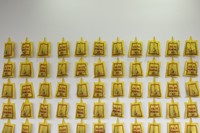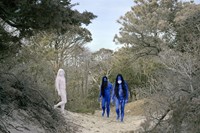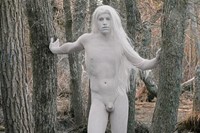Within just a few minutes of entering the Nature Morte gallery space in Berlin, one is met with strange burning smell. “We had a fire ritual in the gallery this morning,” explains artist AA Bronson...
Within just a few minutes of entering the Nature Morte gallery space in Berlin, one is met with strange burning smell. “We had a fire ritual in the gallery this morning,” explains artist AA Bronson, and suddenly things begin to make a bit more sense. Together with Michael Bühler-Rose, he has created an exhibition that engages with the ideas of ritual, the artist as a shaman and the often difficult link between spirituality and artistic practice. The works themselves embody these themes and manifest themselves in a variety of mediums. AA Bronson's living plants sit in the gallery window, a direct reference to a Botanica – a supply store for magical rituals, from which the exhibition takes its name. In another room, Michael Bühler-Rose's series of flame photographs draw on the idea of the aura on the art object, and of course flame rituals. During Gallery Weekend Berlin, we spoke to both artists about the new exhibition and their spiritual vision of the contemporary gallery space.
OK. Let's begin with the idea of a Botanica. How did it inform the art works and the themes that you were both looking at in this show?
AA Bronson: The original idea was to do a collaboration in the form of a Botanica. In America, a Botanica is something that usually pretends to be like a little corner store, but once you're inside you realise you are actually in a supply store for magical rituals. At the front they sell scented candles, then you go a bit further back into the store and there's all the incense and the herbs. They usually have a back room where rituals actually take place. It is really for all of the Afro-Caribbean religions like Santeria and Voodoo, which were a means through which the slaves, when they came to the Americas, were able to pretend to practise Christianity, whilst actually practising their African religions. So the theme of the show was based on the supply stores for witches in a way. So, we were going to do our own Botanica. However, with Michael in New York and me in Berlin it became too complicated. So, instead we chose Botanica as the theme and the works tangentially relate to that. Themes of religion, spirituality and ritual.
Michael Bühler-Rose: We also wanted to acknowledge the gallery space a little bit more than just making a Botanica store front. Our idea of a Botanica takes the form of a normal art show.
I am interested to hear both of your views on the idea of artist as shaman...
AAB: Well, in your case you are actually a practising...
MBR: I have been performing Hindu rituals for a while and I took an initiation in one particular lineage when I was 17. I studied philosophy and Sanskrit in India for many years. So, for me, a lot of my practice is merging my internal spiritual life and my external art practises. Drawing parallels between the artist as priest, art object as a deity, the gallery as a post-Enlightenment temple and the installation of the artwork as a ritual – so we had a ceremony today. Every other gallery is basically trying to turn their artists and their art objects into gods. So, they may not say they are theistic, but I am going to say they are. We are just going and formalising what every other gallery is doing this weekend.
AAB: My own path has been a bit more complicated because my life has wandered in all sorts of different directions. Shamanism is probably too specific a term, but I am very interested in the persona of the artist and a priest or shaman. I am also interested in the ways these figures can merge and the way historically they have merged. Somebody like Joseph Beuys for example, where a big part of his work was his own persona and his beliefs. I like the idea of art as a healing practice, not only on a personal level but on a social level.
"We are drawing parallels between the artist as priest, art object as a deity, the gallery as a post-enlightenment temple and the installation of the artwork as a ritual..."
There is an incredible smell in the gallery, is that from the ritual?
AAB: Yes, we had a fire ritual in the gallery this morning. Unfortunately they cleaned it up a lot. It was just to purify the air and transform the physical space and the metaphysical space. It involved a lot of chanting and a fire.
Michael, can you talk a bit about the flame photographs?
MBR: So, a lot of the works are also about the aura of an art object. The ritual we held this morning wasn't a public performance, but it was about creating an aura and changing the metaphysics of the space. So with the photographic works, they fit into an old video piece I did. There are five different ways you can create fire – by the sun, through a magnifying glass, by mantra, rubbing sticks and by taking elements of the ones I have already listed. These works are called Permanent Photographs of Temporary Images. The only way it can actually exist is through the photographs. It is almost like a conservative documentary approach to it, in a sense. It is an attempt to document an aura.
I am also intrigued by the living plants in the window...
AAB: The plants are maybe the most directly connected to the Botanica idea. I did a lot of research into the plants that were used in witchcraft here in Germany during the middle ages. Particularly plants that were used for rituals, medicinal purposes and also as poison. So the three plants that I have out there come from that kind of history. They are all very poisonous plants. In an actual Botanica, you would probably buy bundles of dried plants. I wanted to use living plants. In fact they all grow in normal gardens. Think back to Agatha Christie novels and you have these old ladies poisoning people with things from their garden. It is kind of like that. There is a piece with three little envelopes of seeds. One is called Death by Drowning – if you ate those seeds you would have a lot of visions and then die. The second one is called Death by Dreaming, and with that one you could fall asleep and die. The third one is called Hallucination, and it is a hallucinogenic seed.
Then moving on to your large 'Blue' photograph...
AAB: That photograph was taken on Fire Island just outside of New York. It is in a part that is still very much a gay resort and has been since the 1940s. In the late 1980s and 90s, a lot of men who were sick went there to spend their last days. It is such a beautiful place. They would then go back into the city to die, but have their ashes scattered on Fire Island. It is a forest filled with the ashes of dead people – many remarkable people. I have been meditating a lot on that place, a place of actual spirits. This piece came out of it. It is a collaboration with the young man in white in the photo, called Ryan Brewer. It is definitely a piece about the idea of the spirits of the dead.
The Botanica is at Nature Morte Berlin until June 1.



